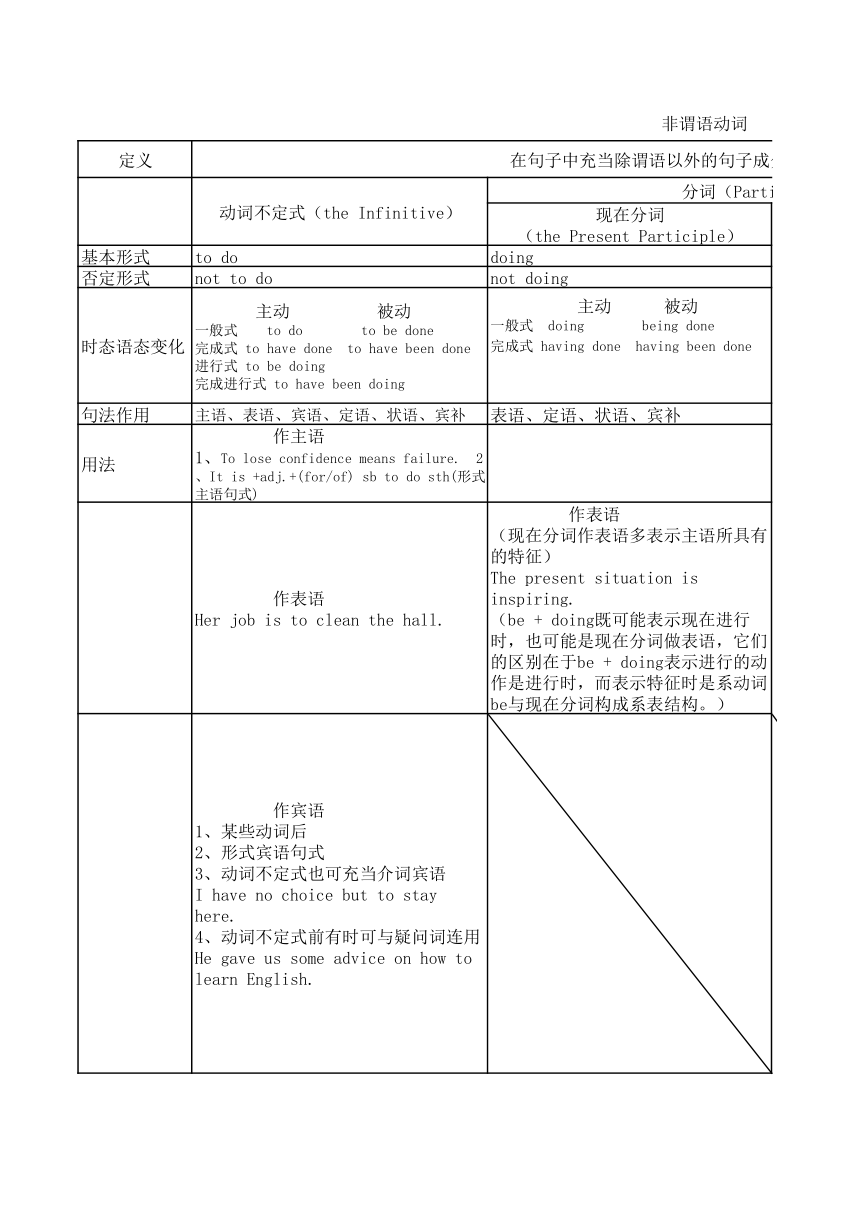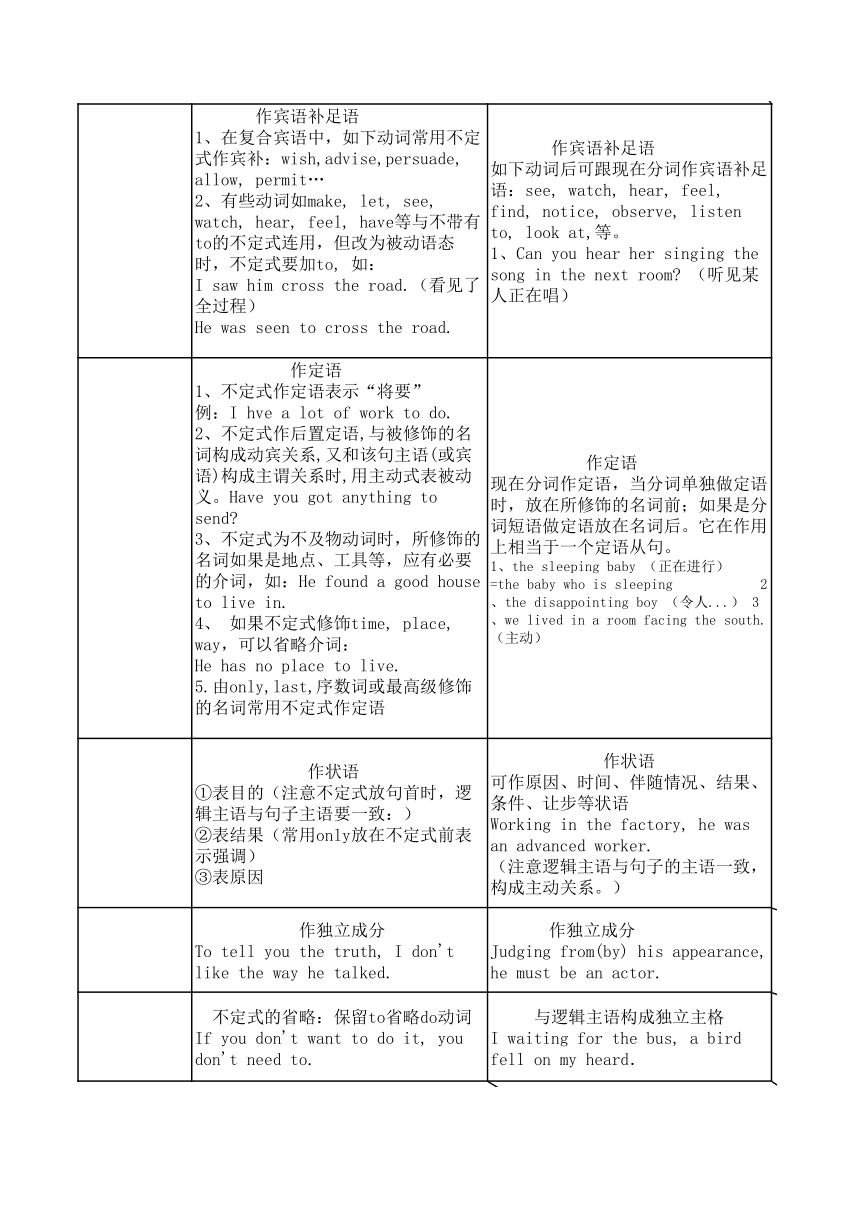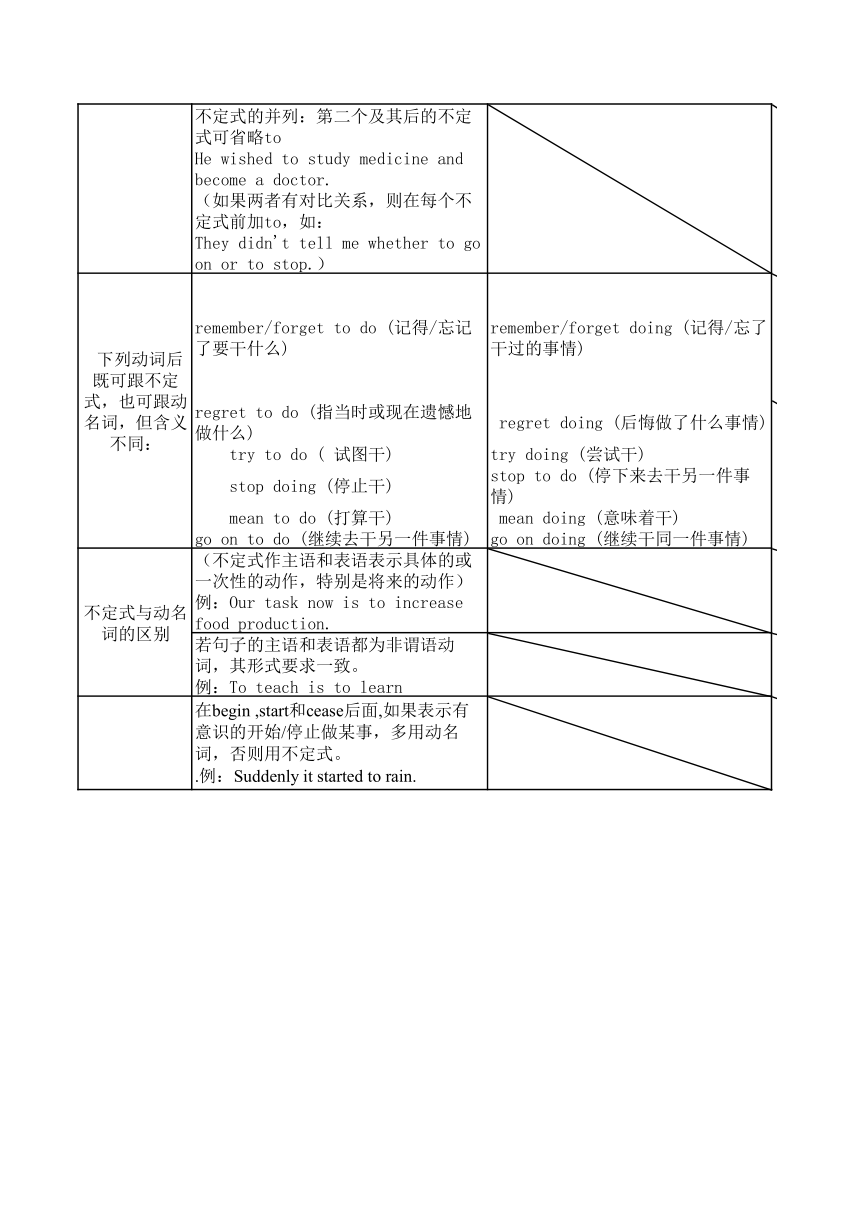非谓语动词(广西壮族自治区桂林市七星区)
图片预览



文档简介
非谓语动词
定义 在句子中充当除谓语以外的句子成分的动词形式叫做非谓语动词。
动词不定式(the Infinitive) 分词(Participle) 动名词 (the Gerund)
现在分词 (the Present Participle) 过去分词 (the Past Participle)
基本形式 to do doing done doing
否定形式 not to do not doing not done not doing
时态语态变化 主动 被动
一般式 to do to be done 完成式 to have done to have been done
进行式 to be doing 完成进行式 to have been doing 主动 被动
一般式 doing being done
完成式 having done having been done
done 主动 被动
一般式 doing being done
完成式 having done having been done
句法作用 主语、表语、宾语、定语、状语、宾补 表语、定语、状语、宾补 表语、定语、状语、宾补 主语、表语、宾语、定语
用法 作主语 1、To lose confidence means failure. 2、It is +adj.+(for/of) sb to do sth(形式主语句式) 作主语 1、Reading aloud is very helpful. 2、It is + no use/no good/...+ doing sth(形式主语句式) P135
作表语 Her job is to clean the hall. 作表语 (现在分词作表语多表示主语所具有的特征) The present situation is inspiring. (be + doing既可能表示现在进行时,也可能是现在分词做表语,它们的区别在于be + doing表示进行的动作是进行时,而表示特征时是系动词be与现在分词构成系表结构。) 作表语 注意:be + 过去分词,如果表示状态是系表结构,如果表示被动的动作是被动语态。区别:
The window is broken.(系表)
The window was broken by the boy.(被动)
作表语 In the ant city, the queen's job is laying eggs.
作宾语 1、某些动词后 2、形式宾语句式 3、动词不定式也可充当介词宾语 I have no choice but to stay here. 4、动词不定式前有时可与疑问词连用He gave us some advice on how to learn English. 作宾语 1、某些动词后 enjoy, finish, suggest, avoid(避免), excuse ,delay, imagine, keep, miss, consider, admit(承认),deny(否认), mind, permit, forbid, practise, risk(冒险), appreciate(感激), be busy, be worth, feel like, can't stand, can't help(情不自禁地) (P135) 2、介词后的宾语 3、某些句型 : 1.have difficulty'trouble (in) doing sth 2.sb. spend time/money (in)doing sth 3.be busy (in) doing sth
作宾语补足语 1、在复合宾语中,如下动词常用不定式作宾补:wish,advise,persuade, allow, permit… 2、有些动词如make, let, see, watch, hear, feel, have等与不带有to的不定式连用,但改为被动语态时,不定式要加to, 如:
I saw him cross the road.(看见了全过程)
He was seen to cross the road.
作宾语补足语 如下动词后可跟现在分词作宾语补足语:see, watch, hear, feel, find, notice, observe, listen to, look at,等。 1、Can you hear her singing the song in the next room (听见某人正在唱)
作宾语补足语 如下动词后可跟过在分词作宾语补足语:see, watch, hear, feel, find, notice, observe, listen to, look at,等。 1、I often hear the song sung in English. (听见歌被唱)
作定语 1、不定式作定语表示“将要” 例:I hve a lot of work to do. 2、不定式作后置定语,与被修饰的名词构成动宾关系,又和该句主语(或宾语)构成主谓关系时,用主动式表被动义。Have you got anything to send 3、不定式为不及物动词时,所修饰的名词如果是地点、工具等,应有必要的介词,如:He found a good house to live in. 4、 如果不定式修饰time, place, way,可以省略介词: He has no place to live. 5.由only,last,序数词或最高级修饰的名词常用不定式作定语
作定语 现在分词作定语,当分词单独做定语时,放在所修饰的名词前;如果是分词短语做定语放在名词后。它在作用上相当于一个定语从句。 1、the sleeping baby (正在进行) =the baby who is sleeping 2、the disappointing boy (令人...) 3、we lived in a room facing the south.(主动) 作定语 注意:当过去分词是单词时,一般用于名词前,如果是过去分词短语,就放在名词的后面。过去分词做定语相当于一个被动语态的定语从句。 1.fallen leaves(已经完成) 2.the excited people(感到...) 3.Those elected as committee members will attend the meeting. (被动) 作定语 drinking water =the water for drinking
作状语 ①表目的(注意不定式放句首时,逻辑主语与句子主语要一致:) ②表结果(常用only放在不定式前表示强调) ③表原因 作状语 可作原因、时间、伴随情况、结果、条件、让步等状语 Working in the factory, he was an advanced worker. (注意逻辑主语与句子的主语一致,构成主动关系。) 作状语 可作原因、时间、伴随情况、结果、条件、让步等状语 Praised by the neighbours, he became the pride of his parents. (注意逻辑主语与句子的主语一致,构成被动关系。)
作独立成分 To tell you the truth, I don't like the way he talked. 作独立成分 Judging from(by) his appearance, he must be an actor. 复合结构 物主代词(或名词所有格)+ 动名词 He suggested our trying it once again. 他建议我们再试一次。
不定式的省略:保留to省略do动词 If you don't want to do it, you don't need to. 与逻辑主语构成独立主格 I waiting for the bus, a bird fell on my heard. 在want、need、require、deserve(值得)等动词后,总是用动名词的主动形式表被动意义,相当于 to be done The room needs cleaning /to be cleaned.
不定式的并列:第二个及其后的不定式可省略to He wished to study medicine and become a doctor. (如果两者有对比关系,则在每个不定式前加to,如: They didn't tell me whether to go on or to stop.) worth 后用动名词的主动形式表被动意义 The film is worth seeing.
下列动词后既可跟不定式,也可跟动名词,但含义不同:
remember/forget to do (记得/忘记了要干什么) remember/forget doing (记得/忘了干过的事情)
regret to do (指当时或现在遗憾地做什么) regret doing (后悔做了什么事情)
try to do ( 试图干) try doing (尝试干)
stop doing (停止干) stop to do (停下来去干另一件事情)
mean to do (打算干) mean doing (意味着干)
go on to do (继续去干另一件事情) go on doing (继续干同一件事情)
不定式与动名词的区别 (不定式作主语和表语表示具体的或一次性的动作,特别是将来的动作)例:Our task now is to increase food production. (动名词作主语和表语表示一般或抽象的多次性动作)例:Walking is a good form of exercise for both young and old.
若句子的主语和表语都为非谓语动词,其形式要求一致。 例:To teach is to learn 若句子的主语和表语都为非谓语动词,其形式要求一致。 例: Teaching is to learning.
在begin ,start和cease后面,如果表示有意识的开始/停止做某事,多用动名词,否则用不定式。 .例:Suddenly it started to rain. 在begin ,start和cease后面,如果表示有意识的开始/停止做某事,多用动名词,否则用不定式。 例:We start working at eight
定义 在句子中充当除谓语以外的句子成分的动词形式叫做非谓语动词。
动词不定式(the Infinitive) 分词(Participle) 动名词 (the Gerund)
现在分词 (the Present Participle) 过去分词 (the Past Participle)
基本形式 to do doing done doing
否定形式 not to do not doing not done not doing
时态语态变化 主动 被动
一般式 to do to be done 完成式 to have done to have been done
进行式 to be doing 完成进行式 to have been doing 主动 被动
一般式 doing being done
完成式 having done having been done
done 主动 被动
一般式 doing being done
完成式 having done having been done
句法作用 主语、表语、宾语、定语、状语、宾补 表语、定语、状语、宾补 表语、定语、状语、宾补 主语、表语、宾语、定语
用法 作主语 1、To lose confidence means failure. 2、It is +adj.+(for/of) sb to do sth(形式主语句式) 作主语 1、Reading aloud is very helpful. 2、It is + no use/no good/...+ doing sth(形式主语句式) P135
作表语 Her job is to clean the hall. 作表语 (现在分词作表语多表示主语所具有的特征) The present situation is inspiring. (be + doing既可能表示现在进行时,也可能是现在分词做表语,它们的区别在于be + doing表示进行的动作是进行时,而表示特征时是系动词be与现在分词构成系表结构。) 作表语 注意:be + 过去分词,如果表示状态是系表结构,如果表示被动的动作是被动语态。区别:
The window is broken.(系表)
The window was broken by the boy.(被动)
作表语 In the ant city, the queen's job is laying eggs.
作宾语 1、某些动词后 2、形式宾语句式 3、动词不定式也可充当介词宾语 I have no choice but to stay here. 4、动词不定式前有时可与疑问词连用He gave us some advice on how to learn English. 作宾语 1、某些动词后 enjoy, finish, suggest, avoid(避免), excuse ,delay, imagine, keep, miss, consider, admit(承认),deny(否认), mind, permit, forbid, practise, risk(冒险), appreciate(感激), be busy, be worth, feel like, can't stand, can't help(情不自禁地) (P135) 2、介词后的宾语 3、某些句型 : 1.have difficulty'trouble (in) doing sth 2.sb. spend time/money (in)doing sth 3.be busy (in) doing sth
作宾语补足语 1、在复合宾语中,如下动词常用不定式作宾补:wish,advise,persuade, allow, permit… 2、有些动词如make, let, see, watch, hear, feel, have等与不带有to的不定式连用,但改为被动语态时,不定式要加to, 如:
I saw him cross the road.(看见了全过程)
He was seen to cross the road.
作宾语补足语 如下动词后可跟现在分词作宾语补足语:see, watch, hear, feel, find, notice, observe, listen to, look at,等。 1、Can you hear her singing the song in the next room (听见某人正在唱)
作宾语补足语 如下动词后可跟过在分词作宾语补足语:see, watch, hear, feel, find, notice, observe, listen to, look at,等。 1、I often hear the song sung in English. (听见歌被唱)
作定语 1、不定式作定语表示“将要” 例:I hve a lot of work to do. 2、不定式作后置定语,与被修饰的名词构成动宾关系,又和该句主语(或宾语)构成主谓关系时,用主动式表被动义。Have you got anything to send 3、不定式为不及物动词时,所修饰的名词如果是地点、工具等,应有必要的介词,如:He found a good house to live in. 4、 如果不定式修饰time, place, way,可以省略介词: He has no place to live. 5.由only,last,序数词或最高级修饰的名词常用不定式作定语
作定语 现在分词作定语,当分词单独做定语时,放在所修饰的名词前;如果是分词短语做定语放在名词后。它在作用上相当于一个定语从句。 1、the sleeping baby (正在进行) =the baby who is sleeping 2、the disappointing boy (令人...) 3、we lived in a room facing the south.(主动) 作定语 注意:当过去分词是单词时,一般用于名词前,如果是过去分词短语,就放在名词的后面。过去分词做定语相当于一个被动语态的定语从句。 1.fallen leaves(已经完成) 2.the excited people(感到...) 3.Those elected as committee members will attend the meeting. (被动) 作定语 drinking water =the water for drinking
作状语 ①表目的(注意不定式放句首时,逻辑主语与句子主语要一致:) ②表结果(常用only放在不定式前表示强调) ③表原因 作状语 可作原因、时间、伴随情况、结果、条件、让步等状语 Working in the factory, he was an advanced worker. (注意逻辑主语与句子的主语一致,构成主动关系。) 作状语 可作原因、时间、伴随情况、结果、条件、让步等状语 Praised by the neighbours, he became the pride of his parents. (注意逻辑主语与句子的主语一致,构成被动关系。)
作独立成分 To tell you the truth, I don't like the way he talked. 作独立成分 Judging from(by) his appearance, he must be an actor. 复合结构 物主代词(或名词所有格)+ 动名词 He suggested our trying it once again. 他建议我们再试一次。
不定式的省略:保留to省略do动词 If you don't want to do it, you don't need to. 与逻辑主语构成独立主格 I waiting for the bus, a bird fell on my heard. 在want、need、require、deserve(值得)等动词后,总是用动名词的主动形式表被动意义,相当于 to be done The room needs cleaning /to be cleaned.
不定式的并列:第二个及其后的不定式可省略to He wished to study medicine and become a doctor. (如果两者有对比关系,则在每个不定式前加to,如: They didn't tell me whether to go on or to stop.) worth 后用动名词的主动形式表被动意义 The film is worth seeing.
下列动词后既可跟不定式,也可跟动名词,但含义不同:
remember/forget to do (记得/忘记了要干什么) remember/forget doing (记得/忘了干过的事情)
regret to do (指当时或现在遗憾地做什么) regret doing (后悔做了什么事情)
try to do ( 试图干) try doing (尝试干)
stop doing (停止干) stop to do (停下来去干另一件事情)
mean to do (打算干) mean doing (意味着干)
go on to do (继续去干另一件事情) go on doing (继续干同一件事情)
不定式与动名词的区别 (不定式作主语和表语表示具体的或一次性的动作,特别是将来的动作)例:Our task now is to increase food production. (动名词作主语和表语表示一般或抽象的多次性动作)例:Walking is a good form of exercise for both young and old.
若句子的主语和表语都为非谓语动词,其形式要求一致。 例:To teach is to learn 若句子的主语和表语都为非谓语动词,其形式要求一致。 例: Teaching is to learning.
在begin ,start和cease后面,如果表示有意识的开始/停止做某事,多用动名词,否则用不定式。 .例:Suddenly it started to rain. 在begin ,start和cease后面,如果表示有意识的开始/停止做某事,多用动名词,否则用不定式。 例:We start working at eight
